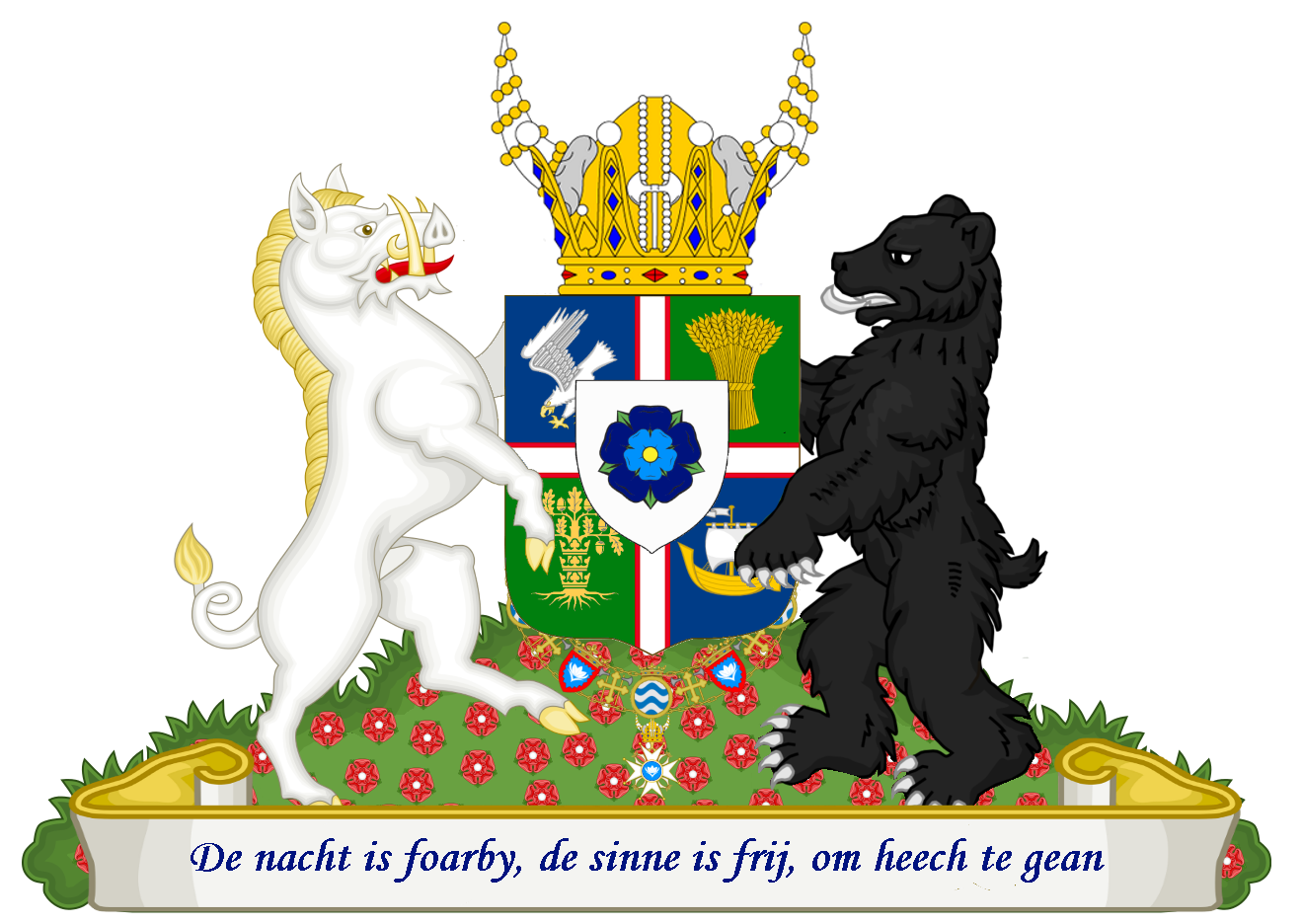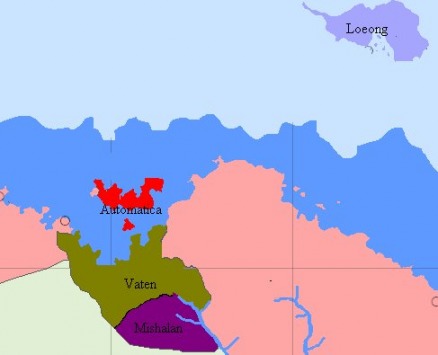Amokolia

|
|
| Feudal Status: | Imperial Dominion |
| Capital: | Anun |
| Largest Cities: | Anun |
|
| |
| Local Leadership Title: | Viceroy |
| Local Government: | Imperial Administration |
| Current leader: | Position Vacant |
|
| |
| Local language: | Istvanistani, Amokolian, Praeta |
| Local Religion: | Amokolian Orthodoxy, Cedrism, Hurmudanish Faith |
Amokolia (in Amokolian: Amokolië; in Mishalanese: Amokoliya; in Elw: Amokool), officially the Imperial Dominion of Amokolia, is a subdivision of the Imperial Republic. It was formerly the largest Royal Precinct of Elwynn during the Froyalanish era as well the second most populous. This abruptly ended following the dismemberment of the Kingdom in the aftermath of the Auspicious Occasion. Whilst Vattnaland remained under the control of the successor Elwynnese Republic, Oleslaad and the Automatica passed under the control of a series of military governorates. This arrangement endured for a decade until, as a consequence of the Elwynnese Civil War (1660–), the territorial components of Amokolia were reassembled in the wake of the second partition of Elwynn.
Historically, Amokolia has been subject to several sovereigns, among them Gralus (1540–1544), Ocia (1553–1557), and Victoria (1559–1572). From 1572 until 1665, Amokolia had for the most part been under Elwynnese sovereignty or jurisdiction, with two exceptions: The Amokolian Federation, a protectorate state of Natopia, and the Soviet Republic of Mishalan.
History
Amokolia was founded in 1526 in Anun, by the endeavour of Jess Heymer to unite the libertarian-anarchic Amokolian peoples under one sovereign. By the end of the next year, Amokolia had expanded into the east Vattnaland region on continental Benacia. The Benacian expansion was deemed complete in 1539 with the addition of Oleslaad and Mishalan as provinces. In 1540, Amokolia joined the newly formed Gralan Empire. The country did not stay long in Gralus, and opted to secede four years later, in 1544.
The newly independent Amokolia sought closer ties with its neighbours, Ashkenatza and Tellia. The friendship culminated in the Benacian Conference between the three powers, wherein they divided the inner Benacian territory among themselves. Amokolia's territory was therefore greatly increased.
The new territories, having not had any government for over 100 years, were in dire need of modernization and infrastructure. The annexation cost the Amokolian government huge sums of money. In turn for the Ocian Federation offering to take on all of the Amokolian government's debts, the Amokolian government agreed to cede its sovereignty to Ocia in 1553. This move was hugely impopular among the Amokolian people, and a series of strikes and demonstrations occurred. Eventually, the Amokolian government (a regional government of Ocia) was more or less forced to declare itself independent, by organizing itself as the Amokolian Provisional Authority (APA). Ocia opposed the matter, and an armed conflict broke out between Ocian forces and the APA. APA diplomats amassed support from anti-Ocian governments abroad, especially with Ashkenatza who had a hostile relationship to Ocia.
In 1556, a full-scale war broke out. Antica, Babkha, Hamland and Shireroth joined Ashkenatza and the APA in driving out the Ocians from Amokolia by 1557. Amokolia's independence was now a reality, but Amokolia's debt to Ashkenatza in the war was paid by cessions of large portions of Amokolia's western and eastern frontiers.
The independent government struggled once more with ruling its country and keeping order there. In 1559, a treaty was therefore signed between Jess and the Victorian Empire, causing Amokolia to become a part of the Victorian empire. Being part of Victoria gave Amokolia stability and much-needed development. However, with mainland Victorian politics coming at an impassé in 1570, Amokolians sought more home-rule once more. They believed that with swapping Victorian sovereignty for Elwynnese, Amokolia would have a greater autonomy. Accordingly, in 1572, the Amokolian Midnight Declaration was announced by a near-unanimous vote of the Association of Amokolian Municipalities. The Declaration called for greater Amokolian home-rule, an end to Victorian sovereignty, and a merger with Elwynn.
Elwynn supported the Midnight Declaration and managed to achieve both Victorian and international recognition of Elwynnese annexation of Amokolia in 1574, albeit at a price: A significant area of Southern Mishalan had to be ceded to Ashkenatza.
Amokolia remained wholely within Elwynn until 1600, when Elwynn reunited with Shireroth. East Amokolia remained in Elwynn, while Oleslaad, Leng and the Islands went to the Amokolian Federation, a protectorate state of Natopia. The protectorate state vacated most of its territory within the next years, keeping only Leng for a while, until the destruction of that island. Elwynn subsequently annexed the Vattnaland and Oleslaad areas of Amokolia.
In 1618, the Amokolian Kingdom was declared by the formerly exiled King Jean, and held territory to the south of Elwynnese Amokolia, as well as holding the Islands. Eventually, that kingdom lost support among its people, and Elwynn annexed those areas as well.
Amokolia expanded steadily westwards into the Batavian lands as it sunk ever deeper into the grips of Froyalanish tyranny. The high water mark came as the Imperial Dominion of Mishalan was annexed into the Kingdom. This relentless expansion was suddenly and dramatically thrown into reverse by the Auspicious Occasion of 1651 when King Noah was abruptly deposed and deported by the Imperial Government. In the subsequent Partition of Elwynn, Amokolia lost all of its mainland territories to the Imperial Government with the sole exception of the eastern strip of Vattnaland.
A large portion of Oleslaad was set aside under a special Imperial administration to serve as a national reserve for Froyalaners and Vanics expelled from Amokolia and Elwynn after the Auspicious Occasion. After a decade of reduction through labour, resettlement into workers colonies, gelding of males, and miscegenation of females, usually by volunteers from amongst their Mishalanski "protectors", the overall number of Froyalaners capable of self-identifying as such has reduced and the first generation of mixed-Froyalanish females are approaching the years of fertility, the footprint of the FNR has reduced to the protected city states of Einhornsby, Selfoss, and the - appropriately named named - new settlement of Terminus. The vacated land has been returned to the Amokolian authorities to remediate and open up for settlement and or economic exploitation.
Names of Amokolia
Amokolia has acquired a variety of names over the course of its existence owing not only to the variety of peoples that call it home but also to the tendency of some ethno-cultural groups, particularly the Froyalanish, to bestow extravagant poetic and attributive names upon the kingdom. This is not an exhaustive list:
- Battlegoose Kingdom;
- Hoary Bone of Contention;
- Jewel in the White Orchid Crown;
- Ye Olde Apple of Discord;
- Þrætuepli.
Demographics
The Kingdom of Amokolia had a total population of 48,265,171 people before The Froyalanish migration of 1651.
| People of Elwynn | Population Size | Percentage |
|---|---|---|
| Absentians | 535,212 | 1.11% |
| Amokolians | 14,743,627 | 30.55% |
| Babkhi | 1,049,159 | 2.17% |
| Boreals | 10,789 | 0.02% |
| Cimmerians | 16,616 | 0.03% |
| Elfinshi | 34,912 | 0.07% |
| Elw | 7,667,150 | 15.89% |
| Farewellish | 264,082 | 0.55% |
| Froyalanish | 20,613,993 | 42.71% |
| Norse | 333,461 | 0.69% |
| Tapferites | 135,846 | 0.28% |
| Haraldian Wintergleamish | 45,475 | 0.09% |
| Other Elwynnese or Shirerithian | 2,451,505 | 5.08% |
| Resident aliens | 363,345 | 0.75% |
Regional Administration
Bailiwicks
The territory of Amokolia is subdivided in fifty Bailiwicks:
- Agningas
- Álafoss
- Alderbaai
- Akrar
- Annike
- Anun
- Aptan
- Bembemhai
- Björkalan
- Björkasbýur
- Capa City
- Capadia
- Cape Tuuler
- Corrigible
- Einhornshahr
- Elfenplatz
- Erion
- Fardë
- Flensborg
- Gendringen
- Gudridsbýur
- Herzenstadt
- Hjalli
- Iskander
- Jacob la Ville-Neuve
- Jyllinge
- Kongsvinger
- Kornebuxuun
- La Terre
- Land van Vinandje
- Luther'enville
- Malexander
- Mittlere Stadt
- Molde
- Mürtin
- Myrthelan
- Neuneuensdorf
- Niü London
- Oleslaad
- Parisia
- Peterburg
- Port Beaumont
- Queensgeese
- Regenbuur
- Rovarsbýur
- Saint Harald
- Schalkwijk
- Selfoss
- Serovopolis
- Stolzfuss
- Tåreskog
- Tel Amok
- Tehuri
- Terravaris
- Thingeyrar
- Tjaldtangi
- Tuulersbýur
- Vålovylowara
Counties
Amokolia's Bailiwicks are grouped into four Counties (replacing the two Circuits established during the Vanic occupation: The County of the Amokolian Islands, the County of Mishalan, the County of Oleslääd and the Circuit of Vattnaland.
County of the Amokolian Islands
The County of the Amokolian Islands is composed of the following Bailiwicks:
- Anun
- Aptan
- Capa
- Capadia
- Fardë
- Luther'enville
- Niü London
- Parisia
- Port Beaumont
County of Mishalan
The County of Mishalan is a unitary authority whose communities are presently unincorporated.
County of Oleslaad
County of Vattnaland
The County of Vattnaland is composed of the following Bailiwicks:
- Alderbaai
- Annike
- Bembemhai
- Gendringen
- Elfenplatz
- Herzenstadt
- Kornebuxuun
- La Terre
- Malexander
- Molde
- Neuneuensdorf
- Peterburg
- Queensgeese
- Regenbuur
- Schalkwijk
- Stolzfuss
Trivia
- From the year 1632, when the area was acquired by Elwynn, until 1638 when it was transferred to the Emirate of Alalehzamin and Utasia, the Vale of Angularis was part of the Battlegoose Kingdom.
- The Precinct Yeomanry of the Kingdom of Amokolia is called Fyrd of the Highlands and the Islands.
- Because of the unrivalled size of the Kingdom of Amokolia within the Elwynnese Union, the Precinct Yeomanry of its western circuit is organised and commanded by the Batavian Knights Charitable and Hospitaller of Amokolia, frequently abbreviated to the Batavian Knights Hospitaller.

